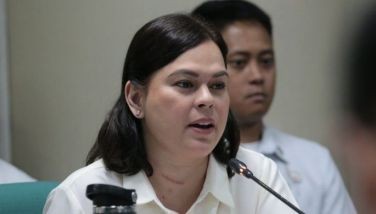For slain journalists

October 14, 2003 | 12:00am
One would think that journalists are free to speak their minds in a country perceived by many to have a free press. If one, however, looks closely at the number of journalists being killed in the practice of their professions, one would think we’re back to living under a repressive regime. Writer Ronalyn V. Olea of Bulatlat.com reveals that since 1986, 71 journalists have been killed – bringing the number of media persons summarily executed since Marcos to a total of 103. These figures came from the Philippine Movement for Press Freedom (PMPF), a media watchdog active during the administration of Aquino and Fidel V. Ramos. From 1972 to 1999, the PMPF documented 87 journalists slain, 34 of them during the Aquino and 19 Ramos administrations.
PMPF had led legal moves and mass protests against the repression of press freedom and the slaying of several journalists. Most of its documentation has been cited by the UN Commission on Human Rights, Amnesty International and the International Federation of Journalist (IFJ). International groups have become seriously concerned over the Philippines being among the top five countries in the world with the biggest number of journalists slain every year.
The Media For Peace, compiling data from the Center for Media Freedom and Responsibility (CMFR) and National Union of Journalists of the Philippines (NUJP) reported a total of five slain journalists under the administration of Estrada and 13 under Macapagal-Arroyo – both in just two years.
Most of the killings, reports Ronalyn, involved government security forces including soldiers, policemen and paramilitary men. Also reportedly involved were politicians, big businessmen and their private security forces.
Many of the killings and other forms of physical harassment took place following the exposés or critical commentaries by the victims of anomalies, illegal activities and other issues.
One of the most celebrated cases was that of a newspaperman in southern Luzon who was forced by a police provincial commander to eat pages of his paper at the point of a gun. Another was the fatal shooting of a radio broadcaster inside his own radio booth. The firing was heard over the radio.
Last month, a prayer vigil was held at the Malate Church by the National Union of Journalists of the Philippines, led by the NUJP vice-president Inday Espina-Varona, managing editor of Philippine Graphic, a weekly magazine, and columnist at the Manila Times.
The wake was held days after the slaying of Jun Pala, a writer for a newspaper in the South, making him the sixth journalists killed this year, and doubling the average number of three a year since 1986. "Now we’re tied with Colombia as the most dangerous place for journalists," says Inday, a political activist who had gone underground under the Marcos regime. Her personal commitment to relevant issues has led her to fighting zones, going to war zones such as Pikit, Cotabato and Basilan, interviewing Moro leaders as well as military men.
She is a passionate fighter for women’s issues, "but basically I’m more known as covering areas of conflict and violations of rights, repercussions, and analysis." She writes what peace journalism is all about – people affected by the war, even the soldiers, "who have their own fears. I write about the women. You can imagine the wives waiting for their husbands." She personally feels the agony of the waiting, she herself having become widowed in 1987 when her husband was killed in an encounter with the military in Bacolod City.
Email: [email protected]
PMPF had led legal moves and mass protests against the repression of press freedom and the slaying of several journalists. Most of its documentation has been cited by the UN Commission on Human Rights, Amnesty International and the International Federation of Journalist (IFJ). International groups have become seriously concerned over the Philippines being among the top five countries in the world with the biggest number of journalists slain every year.
The Media For Peace, compiling data from the Center for Media Freedom and Responsibility (CMFR) and National Union of Journalists of the Philippines (NUJP) reported a total of five slain journalists under the administration of Estrada and 13 under Macapagal-Arroyo – both in just two years.
Most of the killings, reports Ronalyn, involved government security forces including soldiers, policemen and paramilitary men. Also reportedly involved were politicians, big businessmen and their private security forces.
Many of the killings and other forms of physical harassment took place following the exposés or critical commentaries by the victims of anomalies, illegal activities and other issues.
One of the most celebrated cases was that of a newspaperman in southern Luzon who was forced by a police provincial commander to eat pages of his paper at the point of a gun. Another was the fatal shooting of a radio broadcaster inside his own radio booth. The firing was heard over the radio.
Last month, a prayer vigil was held at the Malate Church by the National Union of Journalists of the Philippines, led by the NUJP vice-president Inday Espina-Varona, managing editor of Philippine Graphic, a weekly magazine, and columnist at the Manila Times.
The wake was held days after the slaying of Jun Pala, a writer for a newspaper in the South, making him the sixth journalists killed this year, and doubling the average number of three a year since 1986. "Now we’re tied with Colombia as the most dangerous place for journalists," says Inday, a political activist who had gone underground under the Marcos regime. Her personal commitment to relevant issues has led her to fighting zones, going to war zones such as Pikit, Cotabato and Basilan, interviewing Moro leaders as well as military men.
She is a passionate fighter for women’s issues, "but basically I’m more known as covering areas of conflict and violations of rights, repercussions, and analysis." She writes what peace journalism is all about – people affected by the war, even the soldiers, "who have their own fears. I write about the women. You can imagine the wives waiting for their husbands." She personally feels the agony of the waiting, she herself having become widowed in 1987 when her husband was killed in an encounter with the military in Bacolod City.
BrandSpace Articles
<
>
- Latest
- Trending
Trending
Latest
Recommended



























